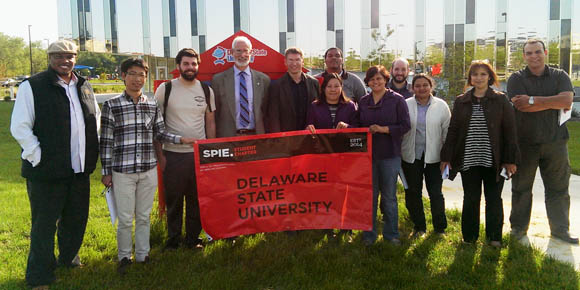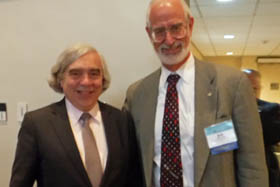Contributions of photonics are vital for resource providing 80 percent of generated energy
 |
| SPIE President Robert Lieberman (fourth from left) met with members of the SPIE Delaware State University Student Chapter in Dover before speaking at the U.S. Department of Energy National Lab Day at the University of Delaware in Newark. (DESU photo) |
NEWARK, Delaware, and BELLINGHAM, Washington, USA -- Photonic sensors can improve safety, efficiency, and resource management for fossil-fuel-derived energy, SPIE President Robert Lieberman told lab leaders, researchers, and industry representatives during the U.S. Department of Energy (DOE) National Lab Day at the University of Delaware in Newark today.
National Lab Day activities included talks and panel discussions with high-level energy lab and university leaders, including luncheon keynote talks by U.S. Energy Secretary Ernest Moniz and Senator Chris Coons (D-Delaware), a supporter of optics and photonics in legislation as well as the International Year of Light in 2015.
The focus of the event was on ways in which DOE-funded research can lead to commercial technologies that enhance energy security, improve environmental health, and contribute to national well-being.
 |
| Energy Secretary Ernest Moniz, at left, and SPIE President Robert Lieberman were among participants at DOE National Lab Day in Delaware. |
Participating in panel discussion on Energy Generation, Dr. Lieberman pointed out that increased deployment of photonic sensors is vitally important, since 80 percent of the energy used on earth is generated from fossil fuel sources.
"Photonic sensors can improve performance in every step of the fossil fuel energy chain, from discovery to disposal," said Lieberman, who is president of the fiber-optics firm Lumoptics LLC. Applications aid in detecting leaks, monitoring groundwater and temperature, ensuring internal combustion energy efficiency, and more.
Technologies such as remote spectroscopy and airborne seismography are employed during exploration, development, and production, to help minimize surface disruption, lessen the environmental impact of drilling and mining, and reduce accidents and injuries, he noted. Laser ultrasonics, optical waveguide sensors, tunable diode lasers, and other photonic technologies can be used in storage, combustion, emission, and sequestration applications.
Lieberman noted ways in which future photonic technologies could further cut fossil fuels’ financial and environmental costs. For example, “exotic" light sources and detectors can be developed to track combustion performance and emissions. Photonics technology also can enable new ways to identify resources as well as improve environmental and human safety.
National Lab Day activities featured talks and panel discussions with high-level energy lab and university leaders, including luncheon keynote talks by U.S. Energy Secretary Ernest Moniz and Senator Chris Coons (D-Delaware), a supporter of optics and photonics in legislation as well as the International Year of Light in 2015.
On Thursday, Lieberman toured Delaware State University (DESU) as the guest of Noureddine Melikechi, professor of physics and vice president for Research, Innovation and Economic Development at DESU, and met with members of the SPIE DESU Student Chapter.
About SPIE
SPIE is the international society for optics and photonics, an educational not-for-profit organization founded in 1955 to advance light-based science, engineering, and technology. The Society serves nearly 264,000 constituents from approximately 166 countries, offering conferences and their published proceedings, continuing education, books, journals, and the SPIE Digital Library. In 2015, SPIE provided more than $5.2 million in support of education and outreach programs. www.spie.org
Contact:
Amy Nelson
Public Relations Manager
amy@spie.org
+1 360 685 5478
@SPIEtweets
All photos © SPIE, the international society for optics and photonics, except where noted.